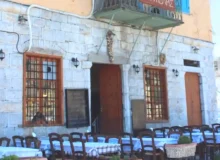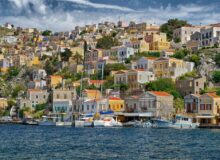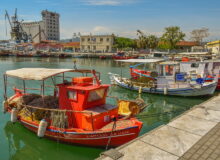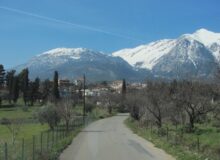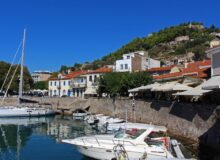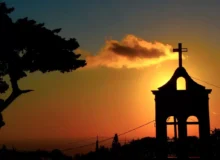The See Greece guide to the archaeological site on the island of Keros in the Cyclades.

Tucked away in the heart of the Cyclades, the small, uninhabited island of Keros is one of Greece’s most enigmatic archaeological sites. Unlike its more famous neighbors, such as Delos or Mykonos, Keros remains largely unknown to mainstream tourism. Yet, this rugged isle holds profound historical significance as a major religious and cultural center of the Early Cycladic civilization (3200–2000 BCE). A visit to Keros is a journey into the mysteries of the ancient Aegean, where thousands of broken marble figurines, sacred rituals, and a lost civilization await discovery.
The Archaeological Significance of Keros
Keros is often referred to as the “Island of Broken Idols” due to the astonishing number of shattered Cycladic figurines found there. Unlike other Cycladic islands where intact artifacts were buried in graves, Keros was a ritual deposit site—a place where ancient people deliberately broke precious marble statues and brought them from across the Cyclades for ceremonial purposes.
The Keros Hoard & the Sacred Rituals
Excavations led by archaeologists Colin Renfrew and Christos Doumas revealed that Keros was not a typical settlement but a sanctuary island. Thousands of fragments of Cycladic figurines, marble vessels, and pottery were found carefully placed in pits, suggesting ritualistic behavior.
The most famous discovery is the “Keros Hoard”, a collection of broken figurines, including the iconic “Keros Harpist” and “Keros Frying Pan” (a ritual vessel with intricate designs). These artifacts indicate that Keros was a major pilgrimage site where people from neighboring islands brought offerings.
Daskalio: The World’s Oldest Maritime Sanctuary
Just off the coast of Keros lies the islet of Daskalio, which was once connected to Keros by a narrow land bridge. Recent excavations have revealed a massive stepped pyramid-like structure built around 4,600 years ago, making it one of the earliest monumental complexes in the Aegean.
Daskalio was a highly organized settlement with advanced architecture, including stone drainage systems, metal workshops, and imported materials from distant islands. The scale of construction suggests that Keros and Daskalio were central to a pan-Cycladic religious network, possibly serving as a precursor to later sacred sites like Delos.
Exploring Keros Today
Unlike Delos, Keros is not open for casual tourism. The island is protected by strict archaeological regulations, and access is restricted to researchers. However, visitors can still appreciate its significance through:
1. Viewing Keros from Nearby Islands
The best way to see Keros is by taking a boat trip from Koufonisia or Amorgos, the closest inhabited islands. Many local boat tours offer sightseeing trips around Keros, allowing visitors to admire its rugged landscape and the ongoing excavations on Daskalio.
2. Visiting the Naxos Archaeological Museum
Since Keros itself is off-limits, the next best way to experience its treasures is by visiting the Archaeological Museum of Naxos, which houses many of the recovered Cycladic figurines from Keros. The museum provides fascinating insights into the island’s role in the Early Bronze Age.
3. Learning About the Ongoing Excavations
Archaeological work on Keros and Daskalio is still active, with new discoveries emerging regularly. The Cambridge Keros Project and the Greek Archaeological Service continue to uncover evidence of this mysterious civilization. Following their findings through documentaries or academic publications adds depth to understanding Keros’ past.
The Rise and Fall of Keros
At its peak (2600–2300 BCE), Keros was a thriving religious center, attracting pilgrims from across the Cyclades. However, by 2000 BCE, the site was abandoned. The reasons remain unclear—whether due to climate change, invasions, or shifting trade routes—but its legacy lived on in later Cycladic and Minoan cultures.
Why Keros Matters
Keros challenges our understanding of early Aegean societies. Unlike later Greek sanctuaries (such as Delos or Delphi), Keros represents a prehistoric ritual center where symbolism, not written records, shaped its history. The deliberate destruction of figurines suggests a complex belief system, possibly linked to rites of passage, ancestor worship, or communal identity.
Conclusion: A Hidden Gem of the Cyclades
Though inaccessible to most visitors, Keros remains one of the most fascinating islands in the Cyclades. Its broken idols, monumental structures, and unanswered questions make it a key piece in the puzzle of early Greek civilization. For those intrigued by archaeology and ancient mysteries, Keros offers a rare glimpse into a world long forgotten—a sacred island that once united the Cycladic people in ways we are only beginning to understand.
For now, Keros keeps its secrets, waiting for future excavations to reveal more of its enigmatic past. Until then, its silent ruins stand as a testament to the ingenuity and spirituality of the Cycladic people, whose legacy continues to captivate historians and travelers alike.















